2022 AP Calculus AB Exam Guide
18 min read•december 3, 2021
AP Calculus AB/BC ♾️
279 resourcesYour guide to the 2022 AP Calculus AB exam
Format of the 2022 AP AP Calculus AB exam
- Multiple Choice - 50% of your score
- 45 questions in 1 hour and 45 minutes
- 30 questions - no calculator
- 15 questions - calculator
- Free Response - 50% of your score
- 6 questions in 1 hour and 30 minutes
- 2 Questions - require a calculator
- 4 Questions - no calculator
When is the 2022 AP Calculus AB exam and how do I take it?
How should I prepare for the exam?
- First, download the AP Calculus Cram Chart PDF - a single sheet that covers everything you need to know at a high level. Take note of your strengths and weaknesses!
- Remember that for AB, you only need to study through Unit 7. Don’t panic if you don’t remember learning anything from the other units😪
- Review every unit and question type, and focus on the areas that need the most improvement and practice. We’ve put together this plan to help you study between now and May. This will cover all of the units and essay types to prepare you for your exam
- Practice problems are your best friends! Both the FRQs and MCQs had several questions that were similar to previous FRQs and the open-sourced multiple-choice questions on College Board (essentially the same questions with different numbers).
- Join Hours 🤝to talk to real students just like you studying for this exam!
Pre-work: set up your study environment
🖥 Create a study space.
📚 Organize your study materials.
📅 Plan designated times for studying.
🏆 Decide on an accountability plan.
🤝 Get support from your peers.
AP Calculus AB 2022 Study Plan
👑 UNIT 1: Limits and Continuity
Big takeaways:
Content to Focus On:
- Methods of Finding Limits
- From a table
- Be able to estimate values not given in a table by using values that were given in a table.
- From a graph
- Be able to use a graph to interpret a limit at an x value.
- Algebraically
- Limit Properties
- Rationalization
- Some limits look unsolvable, (00 or ), but using algebraic manipulation, you can solve them! In unit 4 we learn about another helpful tool for this, L’Hospital’s rule!
- Infinite Limits
- Squeeze Theorem
- The squeeze theorem helps us to find limits of functions that we do not know, by using the limits of a function that is greater than or equal to and a function that is less than or equal to. If we can find the limits of those two functions and they are equal, then our function should have that limit too!
- Continuity and Discontinuity
- Students should be able to prove if a function is continuous as a point, and know the different types of discontinuity! Removable, jump, infinite.
- First existence theorem:
- Intermediate Value Theorem
- This theorem helps us to prove points exist given certain information. Don’t forget to always state or prove the conditions! In this case, it would be that the function is continuous on [a,b].
Resources to use:
- Defining Limit and using Limit Notation: Introduction to limits
- Graphical Limits: Finding limits given a graph.
- Algebraic Limits: How do you find a limit algebraically?
- Continuity Part I & II: Defining a continuous function
- Limits at Infinity: Using limits at infinity to demonstrate function behavior
- Working with the Intermediate Value Theorem: There are two theorems that are related to Unit 1: The Intermediate Value Theorem and The Extreme Value Theorem. Learn about the Intermediate Value Theorem here.
AP Calculus Unit 1 Formulas & Theorems
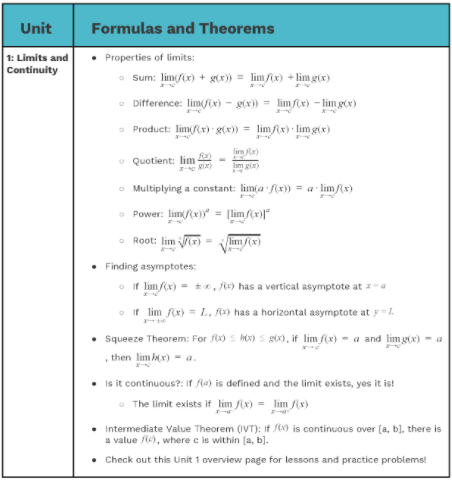
🤓 UNIT 2: Differentiation: Definition and Basic Derivative Rules
Big takeaways:
Content to Focus On:
- Average Rate of Change vs Instantaneous Rate of Change
- If we apply a limit to an average rate of change, we are looking at an instantaneous rate of change!
- Definition of the Derivative
- Estimating The Derivative
- Connecting differentiability and continuity. Remember, differentiability implies continuity, but not the other way around! Make sure you know how to tell if a function is differentiable. No cusps or corners, polynomials are always differentiable!
- Finding Simple Derivatives using:
- Power Rule
- Derivative Properties
- Trigonometric Derivatives
- Exponential and Logarithmic Derivatives
- Product and Quotient Rules
Resources to use:
- The Limit Definition of the Derivative: The derivative from first principles
- Introduction to Finding Derivatives: The power rule and trigonometric derivatives, a must watch!
- The Product and Quotient Rules: The product and power rules, a powerful tool in your derivative-finding toolkit!
- Practicing Derivative Rules: Applying what you’ve learned in finding derivatives so far!
AP Calculus Unit 2 Formulas & Theorems

🤙🏽 UNIT 3: Differentiation: Composite, Implicit & Inverse Functions
Big takeaways:
Content to Focus On:
- Chain Rule
- Chain rule allows us to differentiate composite functions. But make sure you see every function! Sometimes chain rule can be more than one chain! For example: (sin(x2))2. We have 3 functions to consider here!
- Implicit Differentiation
- Implicit differentiation gives us the tools to derive any variable with respect to any variable. The main concept is that if the variable you are deriving is not the same as the variable you are taking the derivative of, chain rule applies and you must also multiply by the derivative of that variable. For example, the derivative of y2 with respect to x is 2ydydx.
- Derivatives of Inverse Functions (Including Trigonometric Functions)
- Remember how to find an inverse? Switch x and y and solve for y? Well then take the derivative of that! or follow the formula we have! The important part to remember on problems like this is the x and y values. If you are supposed to be using the x value of an inverse function, that means it was the y value of your original function!
- The Chain Rule: The chain rule, used to evaluate the derivative of composite functions, is very important!
- Implicit Derivatives: Derivatives of implicitly defined functions/curves
- Practicing Derivative Rules II: Applying what you have learned through the previous 2 units!
- Using Tables to Find Derivatives: Finding derivatives when the equation may not be present
AP Calculus Unit 3 Formulas & Theorems
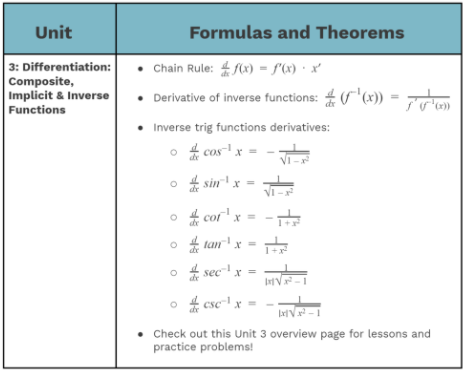
👀 UNIT 4: Contextual Applications of Differentiation
Big takeaways:
Content to Focus On:
- Rates of Change
- Position, Velocity, Acceleration
- Velocity is the derivative of position, and acceleration is the derivative of velocity. Velocity has a direction. If the velocity and acceleration match signs, the particle is speeding up. If their signs are opposite, the particle is slowing down. Speed is the absolute value of velocity and does not have direction. On the AP test, you can be asked to map out the path of a particle, which direction it is going and if it is speeding up or slowing down.
- Related Rates
- Related Rates have to do with nothing other than relating rates! There are a set of steps to follow when solving a related rate:
- 1. Assign letters to quantities and label their derivatives with respect to time. If you have A= area, then dA/dt would be the rate of change of the area.
- 2. Identify the rates that are known and the rate that needs to be found.
- 3. Find an equation that relates the variables whose rates of change you need in step 2. Draw a picture to help you find this equation!
- 4. Differentiate the equation with respect to time. Remember it is necessary to think about this as implicit differentiation.
- 5. Substitute in all known values and variables, and solve for the unknown rate of change.
- One special type of related rate is that of a cone. You should practice a related rate problem with a cone, because it is necessary to write r, the radius, in terms of h before differentiating.
- Linearization and Tangent Line Approximations
- In these types of problems, we use a tangent line approximation for one value that we know and use it to approximate another very close value. Let’s say, x0 is the one we know about, and x1 is the one we need. Then we would use: f(x1)-f(x0)=f'(x0)(x1–x0) to find f(x1).
- L’Hopital’s Rule
- When using L’Hospital’s rule, we have a few things we need to remember! To apply L’Hospital’s rule, your limit needs to be in one of two forms: 0/0 or ∞/∞. To show this in a free response question, you need to show the limits in the numerator and the denominator go to either 0 or infinity separate from each other, then you can use L’Hospital’s rule, which says: xaf(x)g(x)=xaf'(x)g'(x).
Resources to use:
- Related Rates: How to solve related rates problems
AP Calculus Unit 4 Formulas & Theorems
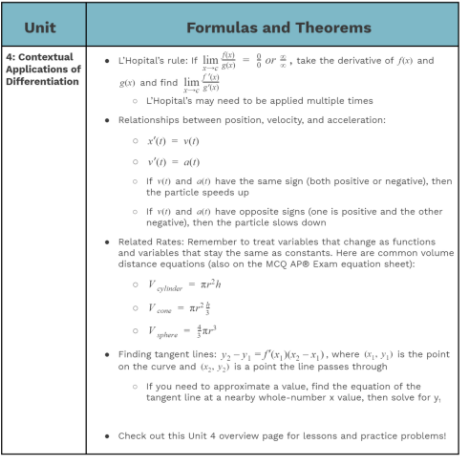
✨ UNIT 5: Analytical Applications of Differentiation
Big takeaways:
Content to Focus On:
- Two of the three Existence Theorems
- It is important to make sure their conditions are met before you use them!
- Mean Value Theorem
- In order to use the Mean Value Theorem, the functions must be continuous on a closed interval and differentiable on that same interval, but open. Once you can say for sure that these things are true, the mean value theorem tells us that there must be a point in that interval where the average rate of change equals the instantaneous rate of change, or the derivative, at a point within the interval. f'(c)=f(b)-f(a)b-a.
- Extreme Value Theorem
- For this existence theorem, the condition is that the function continuous on a finite closed interval. If it is, that means there must be an absolute maximum and an absolute minimum.
- Increasing/Decreasing Functions and The First Derivative
- If the derivative of a function is positive, then the function is increasing! If the derivative is negative, then the function is decreasing!
- Local and Global Extrema
- First and Second Derivative Tests for Local Extrema
- Candidates Test for Global Extrema
- Concavity, Inflection Points, and The Second Derivatives
- If the second derivative is positive, the function will be concave up. If the second derivative is negative, the function will be concave down. Whenever the second derivative changes sign, there will be an inflection point, a change in concavity, on the original function.
- Curve/Derivative Sketching
- All of the information you learned from how the first and second derivatives relate to the original function can help you to sketch graphs based on the information you have about their derivatives!
- Optimization Problems
- These are also known as applied maximum and minimum problems. They are problems about finding an absolute maximum and an absolute minimum in an applied situation. When trying to find an absolute max or min, you must find all critical points (f'(x)=0 or undefined). Then plug those and the endpoints into the original function to find out which has the highest or lowest value, depending on what you are looking for.
- Interpreting Derivatives Through Graphs: Graphical interpretation of derivatives
- Existence Theorems: Mean Value Theorem, Extreme Value Theorem, Intermediate Value Theorem
- Increasing and Decreasing Functions: Using the first derivative to show where function increases and decreases
- Concavity: Using the second derivative to find concavity
- f, f’, and f”: Relating a function and its
- Optimization Problems: How to solve optimization problems
AP Calculus Unit 5 Formulas & Theorems
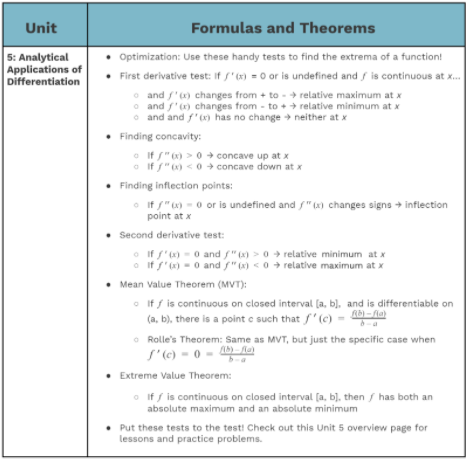
🔥 UNIT 6: Integration and Accumulation of Change
Big takeaways:
Content to Focus On:
- Approximating an integral as an area
- When given a graph, we can find the area under the curve and between the x axis to find the integral. However, if an area is underneath the x-axis, that would be considered negative.
- Riemann Sums
- A way of evaluating an area under a curve by making rectangles to find the area of an adding them up. This is useful with a table of values or with a curve that we do not know the exact area of its shape. There are four kinds: Left, Right, Midpoint, and Trapezoidal sum. Depending on the function, these may be over or under estimates of the actual area.
- Students should also be able to write a Riemann sum in summation notation and integral notation.
- The Fundamental Theorem of Calculus
- This theorem tells us two very important things:
- abf(x)dx=F(b)-F(a)
- ddx(axf(t)dt)=f(x), where a is a constant.
- We use this theorem very often when working with integrals.
- Definite vs. Indefinite Integrals
- Integrals must always include a dx (if not x, whichever variable you are using) at the end.
- If an integral is indefinite, it has no bounds. This means it cannot be evaluated using the fundamental theorem of calculus. Instead, we add on a +C, to make it know that there could have been a constant at the end of the function, and that there are lots of possibilities for what that constant would be.
- Definite integrals have bounds and we use the fundamental theorem of calculus often with them. The bounds let us know the endpoints of the integral, or in terms of a graph, what two points we are finding the area under the curve between.
- Integral Rules
- Make sure you remember how to integrate and its connection to deriving!
- You can check an integral by taking its derivative to see if you get back to where you started.
- U-Substitution
- When you have a composition of functions in an integral, it is necessary to use u-substitution to make sure you are integrating each part. It is usually the inside function which is chosen. Sometimes it can be hard to tell. You will know once you try! If you find yourself going in circles and needing to substitute more, I would try using a different piece of the function as u.
- The Fundamental Theorem of Calculus: Explains the Fundamental Theorem of Calculus and its uses as the most important theorem in calculus
- Some Integration Techniques: How to do integration techniques found in Calculus AB
AP Calculus Unit 6 Formulas & Theorems
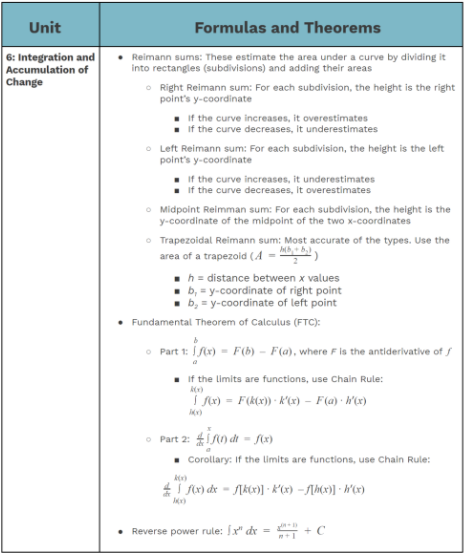
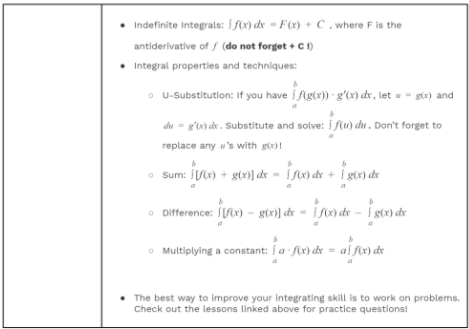
💎 UNIT 7: Differential Equations
Big takeaways:
- Unit 7 takes us to a great connection between integrals and derivatives in differential equations. We will learn how to model and solve differential equations using initial conditions. This always requires separation of variables when it comes to free response questions! We will also learn how to identify differential equations from their slope fields and how to draw those fields as well.
Content to Focus On:
- Differential Equations
- Modeling - If you are given information, can you write a differential equation from it?
- Verifying Solutions - Being able to plug in given information and deduce if the solution is true.
- Separation of variables
- This appears often in the FRQ section. Students are given a differential equation and need to put all of the terms for one variable on one side and for the other variable on the other, then they integrate both sides and solve for y, usually y, but really whichever the dependent variable it.
- NOTE: If you skip the step of separating variables on AP exams in the past, they have offered you no credit for the rest of that section of the problem.
- Using initial conditions
- Once you have done your separation of variables, don’t forget to have a +C! This is where the initial condition comes in. You plug in the terms given from x and y in your initial condition, then you solve for C, rewriting the function at the end with C plugged in!
- Slope fields
- Slope fields are coordinate planes of 1 by 1 sections of slopes at each x and y value. If given a differential equation and asked to find a slope field, you plug in an x and y pair into the differential equation, the value it outputs is the slope at the point, and is the steepness you use to draw a line at that particular pair.
- Separable Differential Equations: How to solve separable differential equations
AP Calculus Unit 7 Formulas & Theorems
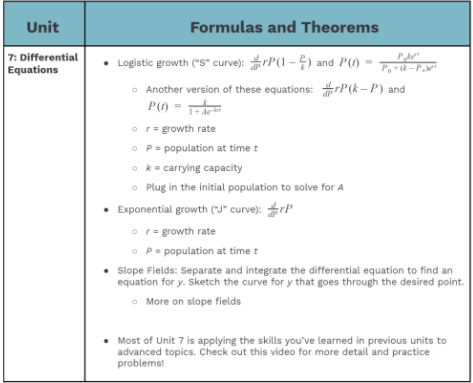
🐶 UNIT 8: Applications of Integration
Big takeaways:
Content to Focus On:
- Average Value of a function
- The average value of a function is denoted by 1b-aabf(x)dx. We can only find the average value of a function that we have a definite integral for.
- Position, Velocity, Acceleration
- Position is the integral of velocity, and velocity is the integral of acceleration! If you take the absolute value of velocity, you are able to find speed.
- Distance is the integral of the absolute value of velocity
- Displacement is the integral of velocity
- To remember this, I think about a track! After one lap around, your distance is 400m, but your displacement is 0. Make sure if you are asked for distance, you remember to use absolute value!
- Finding area between curves
- If given two curves on a coordinate plane and endpoints, students should be able to integrate those functions, either with respect to the x or y axis, in order to determine the area between them. When talking about the x axis, all functions should be in terms of x, the bounds should be in terms of x, and it will be the integral of the upper functions minus the lower. When talking about with respect to the y-axis, all functions should be in terms of y, the bounds should be in terms of y, and it will be an integral of an outer function minus the inner.
- Finding the area between curves that intersect at more than two points.
- Sometimes, your function will have different parts where you may need to split the area and add your answers together, because the upper functions changes, or another function changes.
- When in doubt, break it up into pieces you know how to work with, and add those together.
- Area under the x axis is already accounted for as negative when evaluating using an integral, so don’t worry about that!
- Volumes of cross sections
- When using cross sections, you integrate the area of whatever shape is given to you (this could be a square, rectangle, triangle, or semicircle).
- You will integrate the area on a given interval, but it is important that you interpret the function for the variable in the shape that it represents.
- If it says perpendicular to the x-axis, all should be in terms of x.
- Perpendicular to the y-axis, all should be in terms of y.
- Volumes by disks and washers
- In this case we are integrating an area again, but this time the shape will always be a circle, so we will always be using the area formula for a circle. The variable that changes here is r, the radius, which you can interpret using the function.
- If the rotation is around just the x axis, all should be in terms of x (bounds and functions) and the radius will be your function.
- If the rotation is around just the y axis, all should be in terms of y (bounds and functions) and the radius will be your function.
- If it is rotated around any other vertical or horizontal line, you may need to add or subtract value from your function to find the radius.
- A washer is when two functions are used, and you must subtract out the volume the inner function would have added into your total volume to account for the missing piece.
- Interpreting the Meaning of the Derivative and the Integral: Showing derivatives and integrals applied in different contexts
- Position, Velocity, and Acceleration: Exploring the relationship between position, velocity, and acceleration
- Your guide to the 2022 AP Calculus BC exam
- Format of the 2022 AP Calculus BC exam
- When is the 2022 AP Calculus BC exam and how do I take it?
- How should I prepare for the exam?
- Pre-work: set up your study environment
- AP Calculus BC 2022 Study Plan
- 👑 UNIT 1: Limits and Continuity
- 🤓 UNIT 2: Differentiation: Definition and Basic Derivative Rules
- 🤙🏽 UNIT 3: Differentiation: Composite, Implicit & Inverse Functions
- 👀 UNIT 4: Contextual Applications of Differentiation
- ✨ UNIT 5: Analytical Applications of Differentiation
- 🔥 UNIT 6: Integration and Accumulation of Change
- 💎 UNIT 7: Differential Equations
- 🐶 UNIT 8: Applications of Integration
- 🦖 UNIT 9: Parametric Equations, Polar Coordinates & Vector-Valued Functions
- ♾ UNIT 10: Infinite Sequences and Series
- Your guide to the 2022 AP Calculus AB exam
- Format of the 2022 AP AP Calculus AB exam
- When is the 2022 AP Calculus AB exam and how do I take it?
- How should I prepare for the exam?
- Pre-work: set up your study environment
- AP Calculus AB 2022 Study Plan
- 👑 UNIT 1: Limits and Continuity
- 🤓 UNIT 2: Differentiation: Definition and Basic Derivative Rules
- 🤙🏽 UNIT 3: Differentiation: Composite, Implicit & Inverse Functions
- 👀 UNIT 4: Contextual Applications of Differentiation
- ✨ UNIT 5: Analytical Applications of Differentiation
- 🔥 UNIT 6: Integration and Accumulation of Change
- 💎 UNIT 7: Differential Equations
- 🐶 UNIT 8: Applications of Integration

Fiveable
Resources
© 2023 Fiveable Inc. All rights reserved.